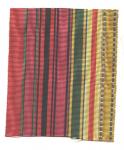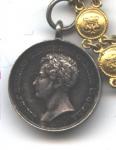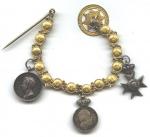-
Posts
785 -
Joined
-
Last visited
-
Days Won
4
Content Type
Profiles
Forums
Blogs
Gallery
Events
Store
Everything posted by Schießplatzmeister
-
Dear Daniel: Thank you for showing us your ribbons! I have identical samples of ribbon that you show in post #21 and in post #23. You are right about the barettes, that was a very popular style during the early to mid-1800's. I am fascinated by these ribbons and I find them rather uncommon. WWI examples are not rare, but are not too often seen either. These pieces are a fascinating diversion for the ribbon collector. Who ever thought that a few inches of silk could signify historical social status and brave deeds to the extent that these little gems do! Gru?, "SPM"
-
Dear Wildcard and Daniel: Thanks for your comments regarding the ribbon. Rick Research wins the prize (he has AMAZING powers which us mere mortals can only dream of obtaining!) for guessing who a probable recipient was. The ribbon belonged to Grand Duke Friedrich I of Baden (or possibly another important male member of the Grand Ducal family). Unfortunately, there is no way to be certain. This ribbon came from Autengruber a few years ago, about the same time that Baden Grand Ducal awards started appearing on the market. So, if one puts this together, it is likely that Friedrich I was the recipient. Yes Daniel, I am very interested in more examples, so let us see them! I have two more examples, but can't post them (I went for quality instead of quantity and used-up my image allowance!). The first example consists of the Baden House Order of Fidelity, Order of the Zahringen Lion, Russia, St. Vladimir Order, and Russia, St. Anne Order. The second example consists of the Baden Order of Fidelity, Baden Military Karl Friedrich Merit Order, and Order of the Zahringen Lion. These all came from the same source and were undoubtedly from the Baden Grand Ducal Household, but alas, there is no way to be certain that they belonged to Grand Duke Friedrich I. Best regards, "SPM"
-
Excellent job Wildcard! I will consider you the winner as we have no other takers! Position #5 is probably a Hessian Ludwig's Order however. It is probable that there is nothing as lowly as a Knight's badge that was part of this grouping, the context leads me to believe that the recipient probably had Grand Cross badges of the listed Orders. OK, Rick and Stogieman, you may now participate! I am beyond my "per post or global limit", so the other photos will have to wait (sorry). Thanks! "SPM"
-
[attachmentid=38589] Hello everyone: Here is my contribution. This is a combination of seven (7) awards. It is 43.5mm wide, and unfortunately not very long, but interesting none-the-less. Sorry, but it should really be turned-around 180 degrees to be viewed properly in the order of precidence. OK, let's have a contest, who can tell me first what the awards are (I know, but thought it would be fun for others to guess)? Please no entries by Stogieman or Rick Research or their immediate families! Rick, here is where you come in, please tell me to whom the ribbon belonged. I have an idea, but it is just speculation. Note that I have two other examples possibly from the same recipient which I will post. Thanks, "SPM" (still around, but busy at work!)
-
Hello Paul: Rick is right (as always!). It looks like a long-serving soldier's group. I would surmise that due to the type of mount it is from the WWI era. Also, there is not 1870 campaign medal (as an 1870 EK recipient would have received). There is also no WWI service honor cross. So, we have a group after the 1870/71 conflict and before 1934 (the fellow probably didn't make it that long). The last medal of course is the 1897 Centennial medal, so he was in the service in 1897. He did no time in the colonies. To summarize, I vote for a 1914 EKII, and a Prussian long-service decoration for 15 years of service as he was probably a senior NCO with all of the time that he had in (1897-1914 minimum). A very nice group. The mounting and assembly look a bit "homemade" which adds a bit of charm to it. I'm sure that this old timer was an asset to his squad on patrol. He obviously did something special to get the life-saving award (either before or during the war). I wonder is he made it through the war? Best regards, "SPM"
-
Hello Rick: This is a very nice early bar. I have some ideas regarding what was on it at some point. The first position was undoubtely for a W?rttemberg 1866 campaign medal. As far as the service decoration possibilities from this era, it is unlikely that he was an officer (active or reserve) because of the lack of much else there, but he may have been a long-serving NCO which would would have made him eligible for the 21 year service cross. I have never seen W?rttemberg pre-1913 enlisted long service clasps made to be suspended from a ribbon and enameled (like the Prussians sometimes did), so this answer is probably feasible. Of course, 1848-49 campaign service is a possibility, but I think that this would be too remote and unlikely, and as you note this group was assembled at a later date, but is for pre-1870 service. I believe that this fellow came on board after 1849 and was out before 1870. Best regards, "SPM"
-
Dear Stogieman: A great observation on your part as to the rarity of the piece in the grouping shown above! I believe that I have a possible answer as to why the Saxon mounted group of four that is pictured above is so rare. First of all, the piece in the first position is the Saxon Albert Order "Kleinkreuz" or "Ehrenkreuz" (as it was known after 1858). There were only 362 awards (Weber, Arnold, Kiel)/386awards (Roth) without swords made! The exact number with swords is not known, but it can only be a handful as I do not believe that any are noted in the common literature. This piece is a true rarity. It was undoubtedly awarded during the 1863/4 or 1866 conflicts as the context of the grouping shows. I doubt that one of these will be seen again during our lifetimes after this is sold and goes into a private collection! Oh, if only I didn't have a mortgage payment, car payments, a spouse, children, etc. Thanks, "SPM"
-
Hello Joe: These are really great cards! I think that interesting items like this are too often overlooked. I find the card showing the encirclement of the Russian detachment in the Carpathians most interesting. This is a soldier's worst nightmare. Fighting on a mountainside on a narrow trail in the snow with enemy forces above AND below. The chances of surviving this sure look remote for them! I'm glad that you found these for a good price at the SOS where in my opinion too many things were terribly overpriced. A good find! Best regards, "SPM"
-
Hello again everyone: I must appologize, for in my haste, I listed 18 GMVK awards for the 1. Garde-Regt. z. Fu? for WWI. There were actually only 16 awards for WWI, and there were 2 awards in 1866! I will now list the rest of the WWI awards for the "Independent" Garde Divisions (some of which may have been considered part of the "Garde du Corps" during WWI at various times). Note that I believe most of these units were not considered "Garde du Corps" except possibly the Garde-F?silier-Regt. and the Lehr-Inf.-Regt. which I believe were part of the 1. Garde Division prior to the Weltkrieg. Garde-F?silier-Regt. : 5 5. Garde-Regt. z. Fu?: 11 Garde-Gren.-Regt. Nr. 5: 6 6. Garde-Inf.-Regt.: 9 7. Garde-Inf.-Regt. : 7 Lehr-Inf.-Regt. : 2 Note that I have not included awards for the various other units attached to the 1st and 2nd Garde-Divisions such as Kavallerie, Feldartillerie, Fu?artillerie, etc., etc. It is interesting to note the years of award for the total of 128 WWI awards for the above-listed units and the 1. Garde-Division and 2. Garde-Division: 1914: 0 1915: 0 1916: 0 1917: 12 1918: 116 Does this indicate an increase in brave deeds toward the end of the war? More troops in battle? I would surmise that the same deed that earned a soldier an EKII in late 1914, would earn him a GMVK in 1918. Of course, in order to be eligible for the GMVK, I believe that a soldier first had to have received the EKII and EKI in theory (I am sure there were instances where awards were made simultaneously for extremely brave deeds!). Just like the Royal Hohenzollern House Order Knight with swords awards for Officers, in 1917 and 1918, the "flood gates" opened. It seems as though political/patriotic considerations made the odds much more favorable for awards to be granted as the war continued. We must keep in mind that this doesn't diminish the importance or esteem of the award however! Best regards, "SPM"
-
Hello again Les: I have of course the names of the recipients and the dates concerning their GMVK awards (has nothing to do with the date of the specific action which led to the award however!). I have both volumes of "Das Ehrenbuch der Garde. Die preu?ische Garde im Weltkrieg 1914-1919" coming shortly. So, if any further information is needed, don't hesitate to ask. Best regards, "SPM"
-
Dear Les: By the way, that is a really nice group because the GMVK appears to be genuine! It is a piece made for a group for everyday wear of course, but genuine pieces of these are not common at all. Usually, one runs across various and sundry MODERN copies which are garbage. I can't wait to see the reverse of this particular piece. Thanks, "SPM"
-
Hello everyone: Here are some numbers regarding the total WWI GMVK awards to the 1st Garde Division and the 2nd Garde Division: 1st Garde-Division (64 total): 1. Garde-Regt. z. Fu?: 18 2. Garde-Regt. z. Fu?: 16 3. Garde-Regt. z. Fu?: 19 4. Garde-Regt. z. Fu?: 11 2nd Garde-Division (26 total): Garde-Gren.-Regt. Nr. 1: 2 Garde-Gren.-Regt. Nr. 2: 7 Garde-Gren.-Regt. Nr. 3: 8 Garde-Gren.-Regt. Nr. 4: 9 Thus, we have a total of 90 awards for these two Divisions under the Garde-Corps-Depot. Unfortunately, any indentification of a specific individual who could have been the recipient of the award shown above would be impossible without more specific information. This information is from Herr Geile's 1997 publication which shows awards broken-down by unit (most helpful!). Other resorces are Ophaus (1936) which is an alphabetical listing, and Patzwall (1986) which lists the award recipients by date of award and alphabetically. There is another book by Nickel (1938), and one by Fischer (1960), but I do not have a copy of those. I hope that this information is helpful! Best regards, "SPM"
-
Hello Tony: Thank you for submitting the interesting photograph. I am not a specialist regarding rank insignia, so I will leave that issue to the many experts here at the forum. The ribbon in the soldier's buttonhole under the EK ribbon seems to be white with very narrow dark-coloured stripes (due to the spacing that is shown). It is difficult to be certain, but my best guess is that the ribbon is for a Bremen Hanseatic cross as this is the only ribbon with this pattern that was commonly awarded. If this is the case, then this is a very interesting photograph indeed, as I have not seen a photo with this ribbon before. Note that it is difficult to be shure however! I'm shure there is someone out there who can help regarding the soldier's unit (and rank), which might give more of a clue as to exactly what ribbon is there! Is there any writing on the rear of the photograph? Thank you, "SPM"
-
Hello again: I forgot to comment on the ribbon which looks like an old silk Prussian lifesaving medal ribbon (although a bit too orange perhaps in the photo/scan). Note that although not the standard RAO ribbon, such a ribbon was possible under extremely-rare special circumstances. Perhaps Rick Research or Medalnet could fill us in regarding the RAO awards with lifesaving ribbons. Best regards, "SPM"
-
Hello folks: I'd just like to throw in my "two cents" regarding this piece. If one looks closely, you will see that the eagle in the medallion is not of the same design as usually encountered pieces. In fact, although the colour looks correct, its execution looks a bit sloppy! I have NEVER seen this type of eagle on a last-type 4th Class cross before. It looks suspiciously very much like the eagles I have seen on counterfeit smooth-armed badges that have been circulating during the last few years and have been generally accepted as genuine. The cross body looks fine. So, this begs the question, is this a rare variety not seen before?, or a well-executed copy? I would RUN away from it at any price! Look to the thread started today by the gentleman from Belgium to see a "standard" Wagner piece. THAT is the type of piece that you want to spend your money on! Thanks, "SPM"
-
Hello Vatjan: Congratulations, you have a very nice example of the last type of the 4th Class RAO. These have been going up in price lately. I would say that the average market price seems to be about EUR 200 lately. Old ribbon stock is not easily found, but it exists in the hands of collectors. I'm sure that a modern nylon ribbon could easily be had for a few dollars, until you might find an original piece. I hope that this helps! "SPM"
-
Hello Wildcard: Sorry for the poor scan, but this format won't allow me to load anything with higher resolution yet. The medal in the middle is the Silver Medal for "Arts and Letters", Oscar II of Sweden/Norway. It is marked "L.A." for Lea Ahlborn. These medals were awarded from 1859-1905/7. The first medal has the die-sinker's mark "HELFRICHT F." and is 18mm in diameter. This of course was the Sachsen-Coburg-Gotha medal for Civic Merit/Arts and Sciences (1835-37, or 1837-58 coinage, I am not sure which). The third cross is still a bit of a mystery. It is like a merit cross of the S.E.H.O., but with a hinged crown. It is made of silver. I have not been able to nail down any official award which looked like it. The reverse simply has the center of a S.E.H.O. merit cross. It would seem strange that the first two awards were made so precisely, but the third seems like a "fantasy" piece. Maybe there is someone out there who can identify it. This recipient also received a Carl XV of Sweden (1859-1872) gold medal. It is not known exactly what that award was as the reverse could not be seen. Unfortunately, that particular miniature piece (buttonhole miniature with ribbons) was purchased by someone else (I did TRY to get it!). Whoever the recipient was, he was rather accomplished in his field (Science, Art, Literature?). Thanks for your interest! Best regards, "SPM"








